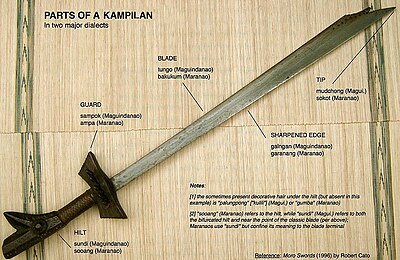Physical description
The Kampilan is a type of single-edged long sword from the Philippines, widely used thr
oughout the archipelago before European c
olonization. In the predominantly Muslim southern Philippines, whereas the Tausug of Sulu favored the barung, the Maguindanao and the Maranao of mainland Mindanao preferred to use the kampilan.
The kampilan has a distinct profile, with the tapered blade much broader, and thinner at the point than at its base, sometimes with a protruding spikelet at the spine side of the tip, and a bifurcated hilt which is believed to represent a figural creature's open mouth.[1]
Among Filipino swords, the most distinguishing characterstic of the Kampilan is its huge size. At about 36 to 40 inches (90 to 100 cm) long, it is much larger than other Filipino swords. In fact, it is thought to be the longest of the traditional Filipino bladed weapons, though small Kampilans (sometimes called the Kampilan Bolo) exist. A notable exception would be the panabas , another Philippine long sword, of which an unusually large example could measure up to four feet (48 inches) long.
Related to the klewang, the blade is narrow near the hilt gradually swelling in width into an almost trapezoidal profile at the end. The blades are often laminated with various styles of tip. Kampilan blades often have holes near the tip sometimes filled with brass. Rarer still some kampilan tips have kris-like fretwork; others have engravings down the entire blade. Although the kampilan can be used with one hand, it is primarily a two-handed sword. At times the hilt was bound to the hand by a talismanic piece of cloth to prevent slippage. Sometimes a chain mail covering was attached to prevent the hand from injury. Almost all kampilans originally had large metal staples protruding from the cross guard above the grip. Hilts were made of hardwood, but expensive datu examples may be covered in silver sheet or made of expensive materials like ivory or bone.
Blade
The Kampilan's laminated steel blade is a single edged made from an Arabic pattern-welding process, and is distinguished by its tapered profile, narrowest near the hilt, and gently widening until its truncated point . The blade is thicker at its base, and thinner at this point, which is accented by a distinctive spike. Some documents describe the Kampilan as "dual-tipped" or "double-tipped".
Sheath or scabbard
The scabbard is usually made of disposable wood and is tied with simple rattan or fiber lashings. When the sword needs to be used immediately, the sword bearer will simply strike with the sheathed sword, and the blade will cut through the lashings, thereby effecting a tactical strike without the need to unsheathe the sword.
The scabbards are very simple and often would be discarded when going into battle. Some scabbards were also made of bamboo or were made with a handle that allowed half of the scabbard to serve as a small shield.
Hilt
The hilt is quite long to counterbalance the weight, and length of the blade, and is made of hardwood.As with the blade, the design of the hilt's profile is relatively consistent from blade to blade, combining to make the Kampilan a combat weapon.
The kampilan's complete tang disappears into a crossguard ("Sampak"), which is often decoratively carved in an Okir (geometric or flowing) pattern.The guard prevents the enemy's weapon from sliding all the way down the blade onto bearer's hand, and also prevents the bearer's hand from sliding onto the blade while thrusting.
The most distinctive design element of the hilt is the pommel , which is shaped to represent a figural creature's wide open mouth. The represented creature varies from sword to sword depending on the culture. Sometimes it is amonitor lizard or crocodile, and more often, a mythical serpent such as the "Naga" or bakonawa, Some Kampilan have animal or human hair tassels attached to the hilt.
Usage
The Kampilan is a weapon used for tribal warfare, used either in small skirmishes or larger scale encounters.According to Philippine historical documents, the kampilan was widely used by chieftains, and warriors for battle, and as a headhunting sword.
In history and culture

Datu Lapu-Lapu the chieftain of Mactan, and his warriors were reported to have wielded this weapon to great effect when they defeated the Spaniards, and killed Portuguese explorer Ferdinand Magellan in the Battle of Mactan on April 27, 1521.[2][1][3] The Kampilan is mentioned in ancient Filipino epics such as the Hiligaynon's' Hinilawod, and the Ilocano's' Biag ni Lam-Ang, implying that the sword was used throughout the Philippine islands. Today, the kampilan is portrayed in art, and tribal tradition.





No comments:
Post a Comment